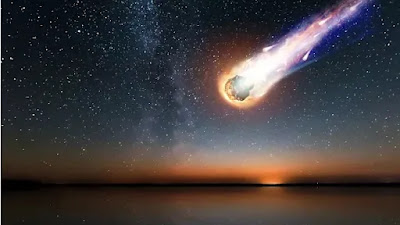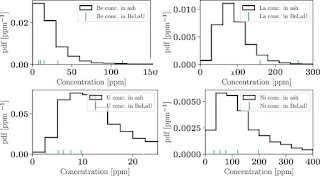The heterodox astronomer Abraham Loeb has been claiming that some small spheres he collected in the Pacific Ocean could be the remains of an extraterrestrial spacecraft. A new study now concludes that those spherules may be coal ash produced in terrestrial factories.
Galileo Project
Harvard University professor Abraham Loeb made headlines around the world in 2017 when he hypothesized that the asteroid 'Oumuamua could be an alien spacecraft.
Recreation of the interstellar object 'Oumuamua" ESO/M. Kornnmesse
Previously, on January 8, 2014, the U.S. Department of Defense observed a bright fireball flying over the South Pacific Ocean in the vicinity of New Guinea. Studying its trajectory and speed, Professor Loeb and his collaborators concluded in 2019 (after the 'Oumuamua episode), that this fireball had also arrived from beyond the solar system, that is, it also had an interstellar origin and that it was possible that it was also an extraterrestrial spacecraft. The meteorite was named IM1 (Interstellar Meteorite -1).
In 2021, Loeb prepared a project, called Galileo, aimed at locating objects that could come from extraterrestrial technological equipment. In June 2023, as part of this project, he organized an expedition to track possible debris from the IM1 fireball that might have been deposited at the bottom of the Pacific. The Galileo project is funded with more than €1.5 million thanks to private donations from various foundations and individuals, including crypto tycoon Charles Hoskinson.
Spherules
As a result of the expedition, Loeb quickly announced that he had located fifty metal spherules that could only have originated from an exoplanet (outside the solar system) or be the remains of an extraterrestrial spacecraft. Loeb thus presented ideas similar to those he had already advanced for the debated object 'Oumuamua. The results were made public in a pre-publication (before being submitted to peer review) which can be consulted here.
One of the spherules collected by the Galileo A Project. Loeb
The spherules found by Loeb are less than a millimeter in size. Prior to the expedition of the Galileo project, by dredging other areas of the ocean floor, many particles of this style had already been collected. Many of them had been recognized as being of meteoritic origin and had been described as "cosmic spherules": they are small fragments of meteors that penetrate the atmosphere and acquire their peculiar spherical shape when burned by friction with atmospheric gases.
But Loeb claimed that the chemical composition of its spherules (in particular, the small presence of nickel and the high abundance of beryllium, lanthanum and uranium) was not consistent with that of other meteorites and therefore concluded that it must have come from beyond the solar system.
The scientific community was always skeptical of Loeb's claims: the fact that the chemical composition of its spherules was not typical of interplanetary meteorites did not guarantee that its origin was interstellar, much less that its origin was an extraterrestrial spacecraft.
Pollutants
A new study by physicist Patricio A. Gallardo of the University of Chicago now adds fuel to the fire. In his work, Gallardo has compared in detail the composition of the spherules (whose technical code is CNEOS 2014-01-08) with samples of various pollutants of terrestrial origin and has concluded that "their meteoritic origin is in question".
Abundance Histograms | RNAAS/P.A. Gallardo
The attached figure shows (green lines) the concentrations of beryllium, lanthanum, uranium and nickel in some of the spherules along with the frequency histograms of such abundances in coal ash (obtained from a very large database called COALQUAL). We see how the abundances of such elements in the spherules fit within the expectations for coal ash.
In short, Gallardo acknowledges that, as anticipated by Loeb, the spherules have high concentrations of beryllium, lanthanum and uranium. But these abundances, along with the low presence of nickel, are typical of the ash produced by burning coal. The simplest hypothesis to explain the origin of spherules would be that they were produced in terrestrial industrial facilities, such as power plants or steam engines.
A Heterodox Scientist
Professor Loeb gained notoriety with his daring hypotheses about the asteroid 'Oumuamua that was discovered in 2017 and which, due to its peculiar trajectory and very elongated shape, was believed to be of interstellar origin. In August 2019, Comet Borisov, with similar characteristics, was discovered and the study of IM1 that had been observed in 2014 was added to all this.
His interpretations in terms of extraterrestrial spacecraft have made Loeb a peculiar character, his media profile is gradually devouring his prestigious research profile as a Harvard professor. Their publications are aired too quickly, before being subjected to the standard system of peer review that guarantees the quality of the papers in the international scientific arena.
Of course, Loeb's ideas are very stimulating and are in no way subjected to any kind of censorship.
But, like all scientific results, Avi Loeb's, before being accepted,
must also pass through the verification filters of the scientific
method.
Patricio Gallardo's article, which has been published in Research Notes of the American Astronomical Society, can be found here.
Rafael Bachiller is director of the National Astronomical Observatory (National Geographic Institute) and member of the Royal Academy of Doctors of Spain.




No comments:
Post a Comment